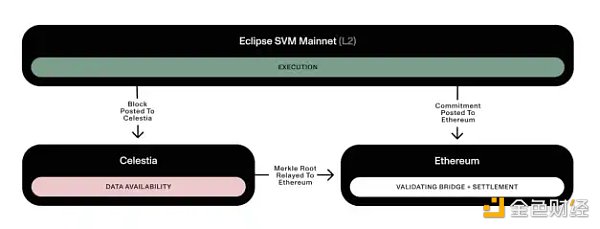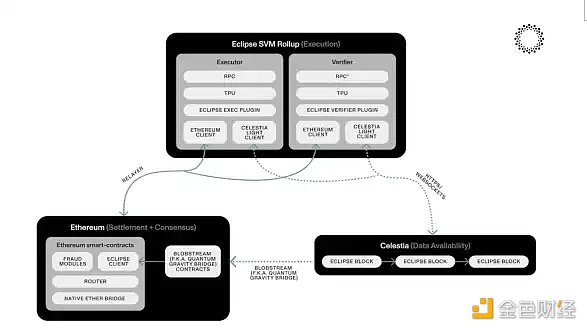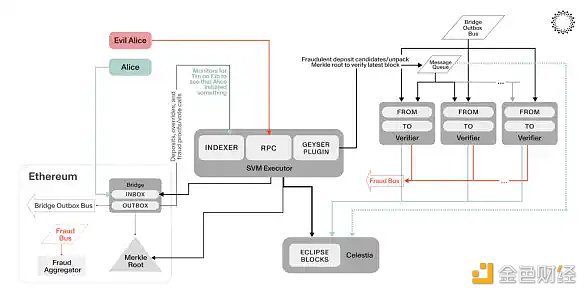Author: YBB Capital Researcher Ac-Core; Compiled by: Block Rhythm
Eclipse founder Neel Somani once worked as a software engineer at Airbnb and Citadel serves as a quantitative researcher and founded the Solana-based startup Eclipse in 2022, and received support from Solana co-founder Anatoly Yakovenko and Polygon (to build a compatible Rollup blockchain for Solana and Polygon).
According to CoinDesk reports on September 28, 2022, Eclipse successfully completed a $6 million Pre-Seed round of financing led by Polychain and A US$9 million seed round co-led by Tribe Capital and Tabiya, bringing the total financing to US$15 million. Eclipse also received a development grant from the Solana Foundation to support Solana Virtual Machine-powered Rollup.
Eclipse founder Somani used his connections and the geographical advantage of being close to Solana's Chicago headquarters to successfully create a unique chain using Solana's virtual machines. The vision is to enable developers to deploy Rollup powered by the Solana VM, with plans to launch a public testnet on the Cosmos ecosystem in early 2023, as well as plans to support Aptos’ Move language in the future.
Solana co-founder and Eclipse angel investor Anatoly Yakovenko commented: "Eclipse paves the way for Solana to communicate with Cosmos through inter-blockchain communication (IBC). ."
Niraj Pant, partner at Polychain Capital, commented: "As large enterprises and governments start to enter the blockchain space, Eclipse is the best solution to facilitate their use cases such as Web2-scale consumer and financial applications)."
Eclipse architecture
The following content According to the official explanation, Eclipse Mainnet is the first universal L2 built around SVM in Ethereum. It combines the best parts of the modular stack and aims to become the fastest and universal Layer 2 of Ethereum driven by SVM. The project architecture uses Ethereum as the settlement layer and is used for the official embedded verification bridge; Celestia as the data availability layer; RISC Zero is used to generate zero-knowledge fraud proofs; and finally Solana's SVM is implemented as a modular Layer2 project as a whole. The following will be explained in detail based on official explanations.
Settlement layer—Ethereum: Eclipse will settle to Ethereum (i.e., the embedded verification bridge on Ethereum) and use ETH as its Gas consumption, And the fraud proof will also be submitted on Ethereum;
Execution layer—Solana Virtual Machine (SVM): Eclipse will run a high-performance SVM as its execution environment. That is, a fork of Solana Labs client (v1.17);
Data availability layer—Celestia: Eclipse will publish data to Celestia to achieve scalable data availability (DA);
Proof mechanism—RISC Zero: Eclipse will use RISC Zero for ZK fraud proof (no intermediate state serialization required);
Communication protocol—IBC: Complete bridging with non-Eclipse chains through Cosmos' inter-chain communication standard IBC;
Cross-chain Protocol—Hyperlane: Eclipse and Hyperlane are partnering to bring Hyperlane’s permissionless interoperability solution to blockchains based on the Solana Virtual Machine (SVM).

Image source: Eclipse official
Settlement layer: Obtaining Ether The security and liquidity of Ethereum
Eclipse uses Ethereum as the settlement layer like other Ethereum Rollups. This process requires Eclipse to be installed on Ethereum. The verification bridge on the platform is directly integrated into Eclipse, and its nodes need to detect the correctness of the verification bridge and correct transaction ordering, so that users can obtain Ethereum-level security.
L2BEAT defines Layer2 as “a chain that derives its security entirely or partially from the first layer of Ethereum so that users do not have to rely on the integrity of Layer2 validators. Ensure the safety of funds." The Eclipse Validation Bridge enforces ultimate validity and censorship resistance under certain failure conditions, allowing users to force completion of their transactions through the bridge and use Ethereum as transaction gas even if the sequencer goes down or censorship begins in L2 Carry out burning.
Execution layer: Obtaining Solana’s transaction speed and scale effects
In order to improve efficiency, Eclipse Mainnet adopts Solana's execution environment, using SVM and Sealevel (Solana is used to build horizontal expansion technical solutions, and the hyper-parallel transaction processing engine is used to horizontally expand across GPUs and SSDs), which is consistent with EVM Compared with single-threaded operation, the advantage is that it can be executed without designing overlapping state transactions, rather than executing sequentially.
Regarding EVM compatibility issues, Eclipse Mainnet has cooperated with Neon EVM to allow developers to leverage Ethereum tools and build Web3 applications on Solana. According to official data, Its throughput is greater than single-threaded EVM, reaching 140TPS level. EVM users interact with applications natively in Eclipse Mainnet through the MetaMask wallet's "Snaps" plug-in.
Data Availability: Leverage the bandwidth and verifiable nature of Celestia
Ecilpse Mainnet will leverage Celestia for data availability and a long-term relationship. The reason is that Ethereum is currently unable to meet Ecilpse's target throughput and fees, which can provide an average of approximately 0.375 per block even after the EIP-4844 upgrade. MB of Blobs space (limit approximately 0.75 MB per block).
According to official data, using ERC-20 transactions based on Rollup expansion, calculated as 154 bytes per transaction, is equivalent to the total of all Rollups, about 213TPS, and For Compression Swap, each transaction is about 400 bytes, and the TPS of all Rollups is about 82TPS. Compared to the 2MB blocks launched by Celestia, Blobstream is expected to increase to 8MB after the network proves stable and more DAS (relevant scaling explained below) light nodes come on and off.
Ecilpse believes that with the support of Celestia's DAS light node, out of consideration of the trade-off between the security of the encryption economy and highly scalable DA throughput, Celestia has become the best choice for Eclipse Mainnet today. Even though there is currently a view that using Ethereum DA is the orthodox Layer 2, the project team will continue to pay attention to the progress in DA expansion after EIP-4844. If Ethereum can provide Eclipse with a larger-scale and high-throughput DA, it will Reassessing the possibility of migrating to Ethereum DA.
Proof mechanism: RISC Zero fraud proof (no intermediate state serialization)
Eclipse's proof method is similar to Anatoly's SVM fraud proof SIMD (see GitHub extension link 2 for details), which is consistent with John Adler's insight to avoid the high cost of state serialization. Therefore, in order to avoid reintroducing the Merkle tree (hash tree) into the SVM, early project parties tried to insert the Sparse Merkle Tree into the SVM, but updating the Merkle tree every time a transaction would have a huge impact on performance. Existing general-purpose rollup frameworks (such as OP stack) cannot serve as the basis for SVM rollup without using Merkle trees for proof, which requires more creative failure proof architectures.
Failure proof requirements: the input commitment of the transaction, the transaction itself, and proof that re-executing the transaction will result in an output different from the one specified on the chain.
Input commitment is usually implemented by providing the Merkle root of the Rollup state tree. The Eclipsse executor will publish the input and output of each transaction (including the account hash value and associated global state) list, as well as the transaction index that generates each input, and publishes the transaction to Celestia so that any full node can follow up, extract the input account from its own state, calculate the output account, and confirm the output account on Ethereum The promise is correct.
There are also two possible major error types here:
Incorrect output : The verifier provides ZK proof of the correct output chain. Eclipse uses RISC Zero to create ZK proofs of SVM execution, continuing the project's previous work proving BPF bytecode execution (see GitHub extension link 3 for details). This allows our settlement contract to ensure correctness without having to run transactions on-chain.
Incorrect input: The validator publishes historical data on the chain indicating that the input status does not match what is claimed. Celestia's Quantum Gravity Bridge is used to allow the Eclipse settlement contract to verify that there is fraud in historical data.
Eclipse’s connection with ETH and Celestia

Source: @jon_charb< /p>
DA is one of the main parts of Rollup cost expenditure. Currently, there are two main methods of data availability in Ethereum L2, Calldata and DAC (Data Availability Committees).
Calldata: Layer2 solutions such as Arbitrum or Optimism publish transaction data directly on-chain as calldata into Ethereum's highly censorship-resistant blocks. Ethereum unifies the pricing of call data, calculation and storage under one unit: Gas, which is also one of the main costs of Rollup's expenditure on Ethereum. To improve efficiency, the EIP-4844 upgrade introduced Blobspace to replace calldata, thereby providing a target value of 375 KB per block for all Rollups;
DAC: DAC has much higher throughput than issuing calldata directly on-chain, but users need to trust a small committee or group of validators to avoid malicious withholding of data. DACs, which also include restaking-based solutions, introduce significant trust assumptions on L2s, forcing DACs to rely on reputation, governance mechanisms, or token voting to inhibit or punish the behavior of withholding data, so to a certain extent When using an external DA, a DAC is required.
It should be added that Celestia uses the Blobstream Proof of Stake consensus network in Eclipse to allow Layer2 to access Celestia's Blobspace, reaching 8 MB blobspace according to the compression scheme This roughly equates to 9,000 to 30,000 ERC-20 transfers per second. However, the use of Blobstream's Layer 2 in the process will rely on Celestia verifier certification. If the light node of the security assurance process detects the malicious behavior of 2/3 of Celestia verifiers by retaining data, they can be punished. Objectively speaking, DAC and the native chain DA There is still a shortcoming compared with the trust level, but this shortcoming is unavoidable when thinking from the perspective of innovation and market narrative.

Source: Eclipse official - Eclipse modular interaction logic
According to The official document explains that as shown in the figure above, Eclipse passes Celestia's Blobstream (as the Ethereum modular DA solution based on DAS extension is introduced above), and the Eclipse data certified to Ethereum has been tested and run, allowing the bridge to be based on Celestia's signature. Data root to verify data security provided for fraud proof. Its users deposit funds into Eclipse through the native Ethereum bridge. The process is summarized as follows:
1. The user calls the Eclipse deposit bridge contract on Ethereum (for the contract address, see Extension link 1);
2.Eclipse is in the SVM executor (calculates the SVM results and outputs them to the Ecilpse new state node), and the repeater (ETH and Eclipse channel) to complete the cross-chain data interaction between the user's sending address and the receiving address;
3. The relay calls the SVM bridge program and is responsible for sending user deposits to the target address;
4. The repeater verifies the deposit transaction through the zk-light client (to be implemented);
5. The final transfer transaction block containing subsequent deposits is completed and published through the Solana Geyser plug-in.
In this process, the SVM executor will publish each Eclipse slot to the message queue through Geyser, and its slot will be published to Celestia as a data block , and Celestia's verifier accepts the submitted data blocks to prove that the transaction is included in the Eclipse chain and corresponds to the data root. Finally, each Celestia data block is relayed to the Eclipse bridge on Ethereum through Blobstream. in contract.

Source: Eclipse Official: Celestia interacts with SVM executor
With At the same time, similar to other Layer 2s in Ethereum that use fraud proofs, the withdrawal of funds between Eclipse and Ethereum also requires a query window period, so that the verifier can submit a fraud proof when the state transition is invalid.
-The SVM executor will periodically release an epoch (process according to a predetermined batch number) of the Eclipse slot to Ethereum to commit and release the mortgage;
p>
-Eclipse's bridge contract performs basic checks to ensure that the published data format is intact (see reference article [2] Fraud Proof Design Chapter for details);
-If the submitted batch passes the basic check, a predefined window will be generated. Within this window, if the batch is committed, it means that the state transition is invalid, and the verifier can publish fraud. Proof;
- If the verifier successfully publishes a fraud proof, they win the executor's guarantee, the published batch is rejected, and the canonical status of Eclipse L2 Rollback to the last valid batch commitment. Here the managers of Eclipse will have the right to elect a new executor;
-but if the challenge period is passed without proof of fraud, the executor will be withdrawn Its collateral and rewards;
-Finally the Eclipse bridge contract completes all withdrawal transactions included in the finalized batch.
Summary
Eclipse is still in the early development test network stage and is based on Ethereum. The first SVM Layer2, the test network is currently online, and the main network is planned to be released in Q1 2024. Ethereum currently still regards Rollup as its core development route. Putting aside the topic of orthodoxy, this means to a certain extent that Ethereum has handed over the broad definition of Layer 2 to the market, so the overt empowerment is also hidden. All forms of competition. Eclipse takes advantage of this and uses modular development to combine the security of Ethereum, the high performance of Solana and Celestia DA to create a strong market narrative.
Looking back at the development process of Ethereum, a very interesting point is that the last round of market conditions was due to the hype of DeFi Summer and the emergence of a large number of "DeFi nesting dolls" and The innovation and overweighting of "DeFi Lego" has caused a spurt in the development of the entire ecosystem. In this round, a large number of "staking matryoshka" and "staking Lego" combinations appeared under the combination of LSD and re-staking, allowing EigenLayer, Blast and Merlin of the BTC ecosystem to reach new highs in TVL in the short term. If we regard matryoshka dolls and Lego as the main theme of market sentiment, then modularity can also play its own matryoshka doll and Lego melody in the future.
The charm of modularity lies in the decoupling benefits of components, thereby realizing innovation at each layer in the stack, so that the optimization of each module can amplify other Optimization of modules, perhaps in the future, the development process of modularization may produce a large number of competitive options for developers and users.
 JinseFinance
JinseFinance







